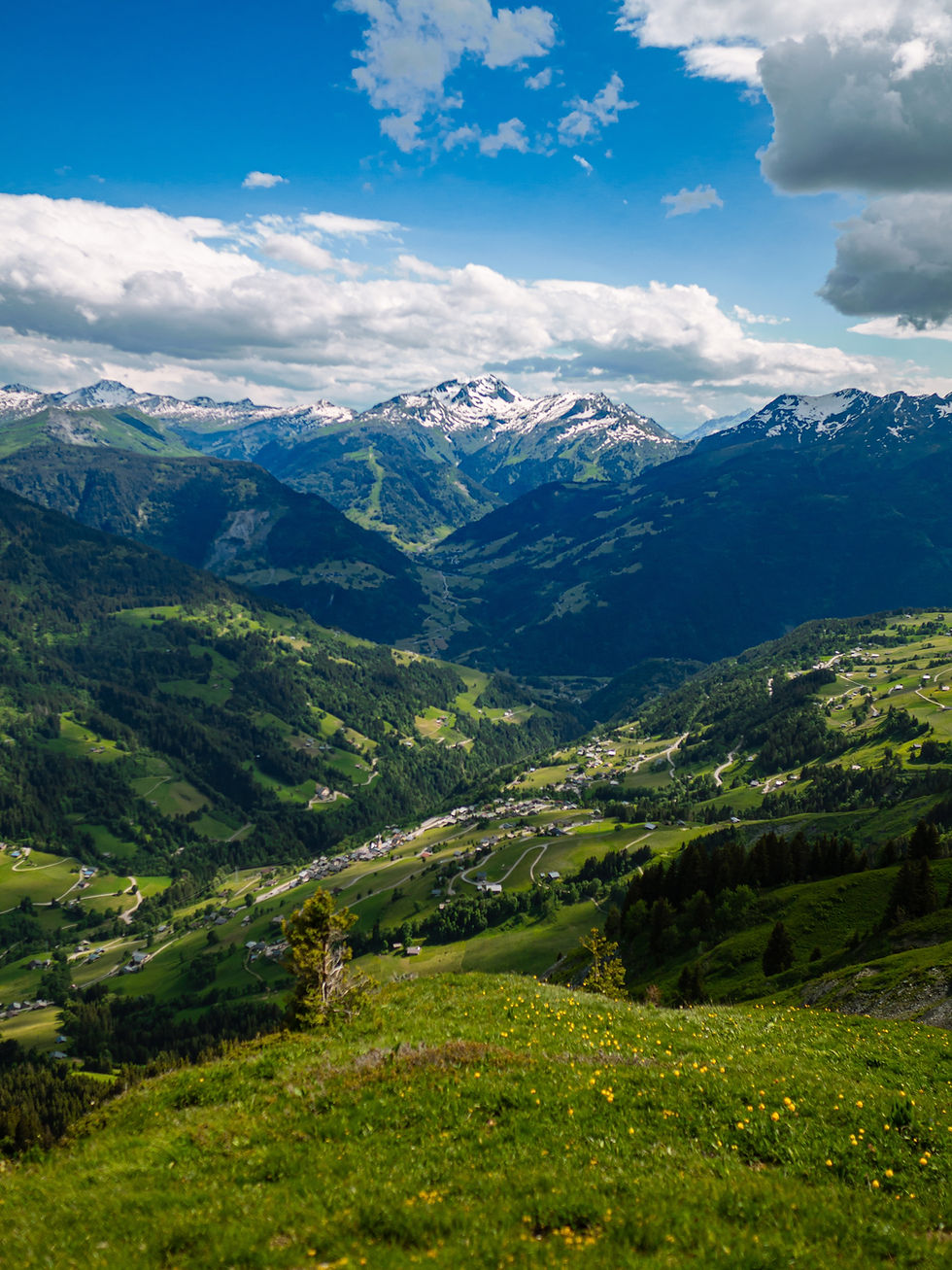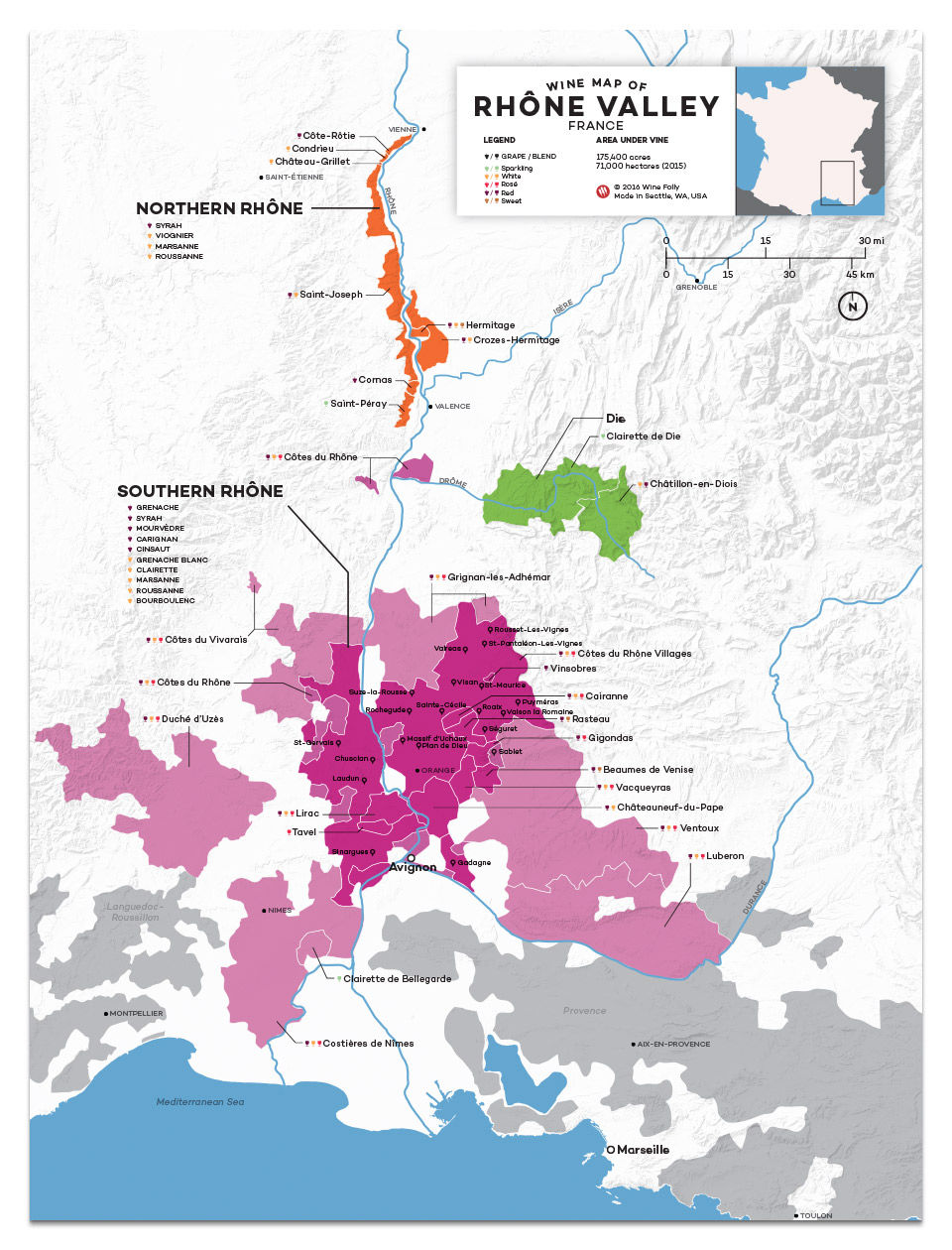RHÔNE VALLEY
- Mar 31, 2023
- 7 min read
OVERVIEW
The Rhône Valley is a famous wine-producing region in southeastern France, stretching from Lyon to Avignon along the Rhône River. It is divided into two distinct regions, the Northern Rhône and the Southern Rhône, each with its own unique terroir and grape varieties.
HISTORY
The Rhone Valley has a long and storied history as a wine-producing region. The ancient Greeks and Romans were among the first to recognize the potential of the region's vineyards, and they planted vines along the banks of the Rhone River as early as the 4th century BC. The wines of the Rhone Valley were highly prized in ancient times, and they were considered among the best in the Mediterranean world.
Throughout the Middle Ages, the wines of the Rhone Valley continued to be highly sought after, and they were frequently exported to other parts of Europe. In the 14th century, the region became famous for its sweet wines, which were made from grapes that had been dried on mats before being pressed. These wines, which were known as vin de paille, were popular throughout Europe, and they were highly prized by the French nobility.
In the 17th and 18th centuries, the wines of the Rhone Valley experienced a period of decline, as the region was affected by war, disease, and economic hardship. However, in the 19th century, the region experienced a resurgence, thanks in part to the work of a number of visionary winemakers who were dedicated to improving the quality of the region's wines.
In the 20th century, the Rhone Valley continued to evolve and innovate, and today it is one of the most dynamic and exciting wine regions in France. From the crisp and aromatic white wines of the Northern Rhone to the rich and complex reds of the Southern Rhone, the wines of the Rhone Valley continue to captivate and delight wine lovers around the world. Whether you are a seasoned wine enthusiast or a curious novice, the Rhone Valley offers an abundance of history, tradition, and flavor to explore and enjoy.

REGIONS
The Rhône Valley is divided into two main regions: the Northern Rhône and the Southern Rhône. These regions are further divided into a number of subregions, each with its own unique terroir and grape varieties.
The Northern Rhône is a small, narrow region that stretches for approximately 40 miles along the Rhône River. It is characterized by steep, terraced vineyards that are planted on slopes that can reach up to 60 degrees in some areas. The region is known for its unique terroir, which is influenced by the river, the climate, and the soils.
There are several subregions within the Northern Rhône, each with its own distinct characteristics and grape varieties.
Côte-Rôtie - This subregion is located in the northernmost part of the Northern Rhône and is known for its steep slopes and terraced vineyards. The dominant grape variety here is Syrah, which is often blended with a small amount of the white grape variety Viognier to add aromatics and finesse to the wine. The wines of Côte-Rôtie are known for their complex aromas of black fruit, spice, and herbs.
Condrieu - This subregion is located just south of Côte-Rôtie and is known for its white wines made from the Viognier grape. The wines of Condrieu are rich and full-bodied with aromas of stone fruit, honey, and floral notes.
Château-Grillet - This tiny subregion is located within Condrieu and is known for its unique, single-estate white wine made exclusively from the Viognier grape.
Saint-Joseph - This subregion is located in the central part of the Northern Rhône and is known for its red wines made from the Syrah grape. The wines of Saint-Joseph are often more approachable than those of Côte-Rôtie and can exhibit aromas of red fruit, spice, and herbs.
Crozes-Hermitage - This subregion is located in the southern part of the Northern Rhône and is the largest appellation in the region. The wines of Crozes-Hermitage are typically made from the Syrah grape and are known for their approachability and affordability.
Hermitage - This subregion is located on a hill overlooking the town of Tain-l'Hermitage and is known for producing some of the most famous and sought-after wines in the Northern Rhône. The wines of Hermitage are typically made from the Syrah grape and can exhibit complex aromas of black fruit, spice, and earthy notes.
Cornas: This small subregion is located on the right bank of the Rhône River and is known for its powerful and complex red wines made exclusively from the Syrah grape. These wines are often described as full-bodied with flavors of black fruit, spice, and herbs.
The Southern Rhône Valley is one of the most famous wine-producing regions in France, and it is known for its rich, full-bodied red wines and aromatic white wines. The region is located in southeastern France, stretching from Avignon to the Mediterranean coast, and it is divided into several distinct subregions.
The primary subregions of the Southern Rhône Valley are:
Châteauneuf-du-Pape: This is the most famous and prestigious subregion of the Southern Rhône, known for its powerful and complex red wines. The wines of Châteauneuf-du-Pape are made from a blend of up to 13 different grape varieties, including Grenache, Syrah, Mourvèdre, and Cinsault.
Gigondas: This subregion is located just east of Châteauneuf-du-Pape, and it is known for its full-bodied and structured red wines. The wines of Gigondas are typically made from a blend of Grenache, Syrah, and Mourvèdre.
Vacqueyras: Located just north of Gigondas, Vacqueyras is known for its rich and powerful red wines, which are made from a blend of Grenache, Syrah, and Mourvèdre.
Beaumes de Venise: This subregion is known for its sweet and fortified Muscat wines, which are made from the Muscat grape.
Lirac: This subregion is located on the western bank of the Rhône River, and it is known for its full-bodied and complex red wines, which are made from a blend of Grenache, Syrah, and Mourvèdre.
Tavel: This subregion is known for its dry and refreshing rosé wines, which are made from a blend of Grenache, Cinsault, and Syrah.
Rasteau: This subregion is located to the south of Gigondas and produces full-bodied, spicy red wines made from Grenache, Syrah, and Mourvèdre grape varieties. The wines of Rasteau were granted AOC status in 2010.
Côtes du Rhône: This is the largest appellation in the Rhône Valley. The vineyards of Côtes du Rhône cover a vast area, stretching from Vienne in the north to Avignon in the south. The wines produced in this appellation are typically full-bodied and fruit-forward, with flavors of blackberry, cherry, and spice.
Côtes du Rhône Villages: This is a collection of 95 villages that are allowed to use their name on the label of their wine. The wines produced in Côtes du Rhône Villages are generally considered to be of higher quality than those from the broader Côtes du Rhône appellation, and they are typically fuller-bodied and more complex, with flavors of dark fruit, herbs, and spices.

VARIETALS
In the Northern Rhone, the primary grape varietals are Syrah and Viognier. Syrah is a dark-skinned grape that is known for producing full-bodied, robust red wines with flavors of dark fruit, black pepper, and smoke. Viognier is a white grape that is used to produce aromatic, floral white wines with flavors of apricot, peach, and honeysuckle.
In the Southern Rhone, there are many different grape varietals that are used to produce the famous blends of Chateauneuf-du-Pape and other regional wines. The most important grape varietals in the Southern Rhone include Grenache, Syrah, Mourvedre, and Cinsault. Grenache is a red grape that is known for producing wines with flavors of red fruit, spice, and leather. Syrah and Mourvedre are also used to produce full-bodied red wines with complex flavors and aromas. Cinsault is a lighter-bodied red grape that is used in blends to add color and acidity.
In addition to these primary grape varietals, there are many other grape varietals that are grown in the Rhone Valley, including Carignan, Counoise, and Roussanne. Each of these grape varietals adds its own unique flavors and characteristics to the wines of the Rhone Valley.
TERROIR
Northern Rhône
Soil:
The soil in the Northern Rhone Valley is diverse, with each appellation having its own unique soil composition. Generally, the region's soils are composed of granite, schist, and gneiss, which contribute to the region's signature minerality and earthiness in the wines. The soils in the Northern Rhone Valley are well-draining and low in fertility, which helps to produce wines with concentrated flavors and aromas.
Climate:
The climate in the Northern Rhone Valley is continental, with hot summers and cold winters. The region is protected from the mistral wind, a strong and cold wind that blows through the valley, by the surrounding hills and mountains. The climate in the Northern Rhone Valley is ideal for the cultivation of Syrah grapes, which thrive in warm temperatures and ample sunshine. The region experiences a long growing season, which allows the grapes to ripen fully and develop complex flavors and aromas.
Topography:
The topography of the Northern Rhone Valley is characterized by steep hillsides and terraced vineyards that are carved into the slopes of the valley. The hillsides in the region provide excellent exposure to sunlight and protect the vines from frost and cold air drainage. The steep slopes also create a natural drainage system, which helps to regulate the water supply to the vines and prevents waterlogging. Southern Rhône
Soil:
The Southern Rhone Valley has a diverse range of soils, including limestone, clay, sand, and gravel. The combination of these soil types creates a variety of microclimates that allow for the cultivation of different grape varietals. For example, the soils in Chateauneuf-du-Pape are dominated by large, rounded stones known as "galets," which absorb heat during the day and radiate it back at night. This helps to ripen the grapes more fully, producing wines with higher alcohol content and greater concentration of flavor.
Climate:
The Southern Rhone Valley has a Mediterranean climate, characterized by hot, dry summers and mild winters. The Mistral, a cold, dry wind that blows down the Rhone Valley from the north, helps to regulate the temperature and humidity in the vineyards. This wind also helps to keep the grapes dry and healthy, reducing the risk of fungal diseases.
Topography:
The Southern Rhone Valley is a hilly region, with vineyards planted on slopes and terraces. The topography of the region plays an important role in the production of high-quality wines, as it helps to ensure good drainage and exposure to sunlight. The vineyards in the Southern Rhone Valley are often planted on south-facing slopes, which receive more sunlight and heat than north-facing slopes. This helps to ripen the grapes more fully and produces wines with greater complexity and intensity.



Comments